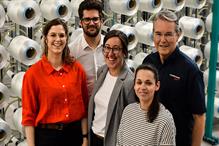
Set to be phased in over the coming weeks, Bcomp’s bodywork solutions will provide a sustainable alternative to the GT4’s existing carbon fibre panels, offering equivalent mechanical performance in stiffness and weight and improving safety. The powerRibs reinforcement grid uses the high specific bending stiffness of flax to build up height very efficiently, boosting the flexural stiffness of thin-walled shell elements significantly. The new bumpers are also safer in the event of a crash or collision and decrease the risk of punctures significantly. Unlike the sharp fracturing and splintering of carbon fibre, ampliTex technical fabrics are far more ductile in an impact, whereas the powerRibs confine the damage zone, minimising debris and the risks to drivers, marshals, and spectators, Bcomp said in a media statement.
A full sustainability analysis concluded that the new bumper offered a total material emission reduction of 90 per cent when compared to the carbon fibre part as well as an 85 per cent reduction of CO2 emissions from cradle-to-gate, considering all production steps from raw material to final part. Not only do Bcomp’s materials reduce the part’s carbon cost, but they also introduce the option of thermal energy recovery. Since the new bumper is full of natural fibre, it can be used for thermal energy recovery, turning approximately 80 per cent of the energy stored in the part into renewable energy, resulting in a process without hazardous carbon waste or parts that need to go into landfill.
Reverse engineered from HWA’s original, the natural fibre bumper’s design has been collaboratively optimised over the past 12 months. To ensure that the bumper met all racing regulations and requirements, the HWA team performed extensive mechanical testing and validation. On the HWA testbench, the stiffness of the complete frontend of the Mercedes-AMG GT4 was measured, simulating the aerodynamic drag and front diffuser downforce. The tests were conducted with a carbon fibre bumper as benchmark and afterwards with the new natural fibre bumper, validating that the newly designed part performs on the same high-performance level.
“The topic of sustainability plays a major role in our company. Several awards for our efforts in the area of environmental protection are proof of this. Part of our sustainability concept is to evaluate and optimise the product life cycle with regard to environmental aspects as early as in the product development stage. Furthermore, it is our aspiration to constantly adapt our long-standing engineering know-how to current environmental requirements in order to be able to offer our customers sustainable products at the highest technological level. In Bcomp, we have got a development partner with extensive experience in sustainable materials. The result of our cooperation shows that technologically equivalent components can be created from alternative materials,” Anne Mink, manager technical development, HWA, said in a statement.
“We are incredibly excited to see HWA and the Mercedes-AMG GT4 race car programme embracing sustainable, natural fibre bodywork. With equivalent stiffness and weight, increased safety and an 85 per cent reduction in carbon emissions, it is a fantastic improvement that we reached together. Development coincided with the height of the pandemic, and it was challenging at times. In fact, our first bumper build, design fitting, optimisations and revisions were all achieved during the pandemic – a testimony to the hard work and persistence of all involved. It has been a pleasure to work with the talented HWA team and we very much look forward to investigating further applications in race and high-performance road cars,” Christian Fischer, CEO and co-founder of Bcomp, said.
Fibre2Fashion News Desk (GK)

